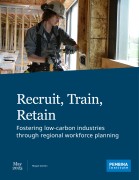Over the past few months an unprecedented level of broadly-based support has emerged across diverse groups — including business, the environmental sector, labour and local communities — for a recovery strategy that can increase both public and private investment in energy efficiency and the decarbonization of buildings, industry, and transportation and energy systems.
We want to take this opportunity to recap three areas for investment we believe need to be prioritized to ensure Canada's recovery strategy addresses new public health and employment needs, as well as the need to achieve significant progress by 2030 on our commitment to net-zero emissions by 2050.
1) Invest in building an inclusive, net-zero workforce.
- Grow employment opportunities in sectors and services that will be in demand as the world seeks to limit warming to 1.5 degrees Celsius.
- Focus training efforts on groups that have been disproportionately impacted by the pandemic and in sectors of the Canadian economy that face new challenges in a world that is decarbonizing. These include women, youth, people of colour, new immigrants, Indigenous communities, and parts of traditional industrial and rural workforces.
2) Invest in resilient, job-intensive, clean and natural infrastructure.
- Grow economic activity in sectors with high jobs per dollar investment ratios, like retrofitting existing and building affordable but more energy efficient and climate-resilient homes and buildings.
- Plan and build the transportation and energy infrastructure that will enable Canada to leverage its current leadership in clean electrification to also be a leader in non-emitting movement of passengers and goods.
- Further decarbonize Canada’s electricity system through investment in updated infrastructure, adoption of clean energy technologies, improved connectivity between provinces, and small-scale renewable energy generation, including in remote communities.
- Support self-sufficiency in large and small Canadian communities by developing the decentralized supply chains needed to build a clean economy, such as building components and batteries.
- Support Indigenous and community-based leadership in the development and deployment of new strategies for ecosystem health and restoration as an important tool for climate resilience and economic diversification.
3) Invest in the development of industries and businesses producing, and scaling up, the use of low- and non-emitting goods and services.
- Align support across sectors with commitments and plans to meet net-zero emissions.
- Grow Canadian expertise and next generation technology for emissions reduction (including hydrogen and carbon removal) in large, carbon-intensive industrial sectors (like steel and cement) and energy systems that are going to take longer to decarbonize.
- Grow Canadian leadership in manufacturing sectors that are already in demand, such as near-zero and zero-emissions vehicles.
- Grow Canadian exports of clean technology and clean energy.







